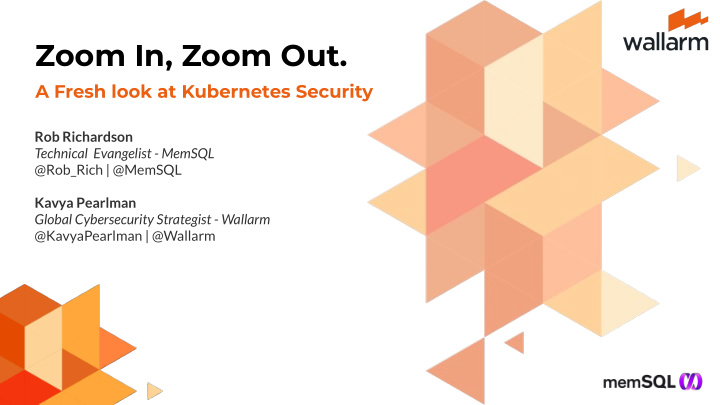



Zoom In, Zoom Out. A Fresh look at Kubernetes Security Rob Richardson Technical Evangelist - MemSQL @Rob_Rich | @MemSQL Kavya Pearlman Global Cybersecurity Strategist - Wallarm @KavyaPearlman | @Wallarm
Introducing Rob... Rob Richardson Tech Evangelist for MemSQL ● Microsoft MVP ● Leads the Southeast Valley .NET User Group ● AZGiveCamp Organizer ● Personal interests Travel, Coding, and Teaching 2
Introducing Kavya... Kavya Pearlman Well known as the “Cyber Guardian” ● Cybersecurity Strategist at Wallarm ● An Award-winning Cybersecurity Professional ● Founder and CEO of XR Safety Initiative ● Former Information Security Director Linden Lab ● Former Facebook Third Party Security Risk Advisor ● Personal interests Travel, Gaming, Virtual Worlds 3
Agenda Let's Talk About Kubernetes! Overview of Containers ● Monolithic vs Microservices ● What is Kubernetes and its Benefits ● Securing K8 - Zooming in ● Essentials to build a secure Kubernetes environment ○ Securing K8 - Zooming Out ● ○ Do’s and Don’ts for Containerized Environments How Istio and Service Mesh can affect security ● Conclusion ● 4
Kubernetes - Getting started KUBERNETES NEEDS NEW SECURITY MINDSET Cloud-native applications and infrastructure create several new challenges for all of us security professionals. We need to establish new security programs, have a new mindset and adopt advanced new tools that are focused primarily on securing cloud-native technologies.” - Kavya Pearlman 5
Monolith vs. Microservices User Interface User Interface Business Logic Data Layer Microservice Microservice Microservice MONOLITH APPLICATION DB DATA SOURCE DATA SOURCE DATA SOURCE 6
Containers vs. VMs App App App Containers are isolated, but share OS and, where A B A’ appropriate, bins/libraries Bins/ Bins/ Bins/ Libs Libs Libs App App App App App App A A’ B B’ B’ B’ Guest OS Guest OS Guest OS Bins/Libs Bins/Libs Hypervisor Container Orchestrator Host OS Host OS SERVER SERVER VIRTUAL MACHINE CONTAINERS 7
What is Kubernetes? Kubernetes Master Controller Manager API Server Scheduler Developer/ Users Operator etcd Kubelet cAdvisor Kube-Proxy Kubelet cAdvisor Kube-Proxy Pod Pod Pod Pod Pod Pod Pod Pod Kubernetes Node Kubernetes Node 8
Benefits of using Kubernetes Bring new products Enjoy peace of mind that Avoid vendor lock-in to market faster your applications are always on Kubernetes self-heals Kubernetes auto-scales 9
Benefits of using Kubernetes It’s the de facto standard Free community support or for running cloud-native paid professional services applications at scale 10
Kubernetes - Zooming In The Essentials for Building a Secure Kubernetes Environment
Shopify Breach Caused by lack of K8 security Essentials Exploited Weakness API configuration flaw Type of attack SSRF Attack whereby metadata used to steal API keys and credential packets Effect Thousands of stores and store-clients information was exposed
Tesla Breach Caused by lack of K8 security Essentials Exploited Weakness: Kubernetes instance and an insecure administrative console Type of attack False credentials Effect The total scope of the breach is yet unknown
What is Docker? Docker hub Container docker hypervisor Dockerfile Image Docker swarm docker hypervisor docker-compose.yml Images 14 Docker ecosystem, infographic by Rob Richardson robrich.org
What is Kubernetes? Docker hub Container docker hypervisor Dockerfile Image Docker swarm docker hypervisor docker-compose.yml Images 15 Docker ecosystem, infographic by Rob Richardson robrich.org
“ “ Namespaces “K8s does not provide a mechanism to enforce security across Namespaces. You should only use it within trusted domains and not use when you need to be able to provide guarantees that a user of the cluster or pods be unable to access any of the other Namespaces resources” --GCP Team tl;dr : A namespace is not a security boundary for inter-pod communication. 16
Role based access control (RBAC) Roles and ClusterRoles are a whitelist ; essentially a list of the allowed permissions. RoleBindings and ClusterRoleBindings marry users to roles: Subject includes the person, place, or thing that has been whitelisted. ● Ex) a developer, DevOps, a team member, user, or process. Resource is the kind of object ● Ex) pod, service, the cluster itself, or another logic instance related to Kubernetes. Operations that are whitelisted are action we permit the system to do. It's an action related ● to REST method. Namespace is the kubernetes section that is allowed. ● 17
Network Policies “By default, pods are not isolated; they accept traffic from any source.” GCP – https://kubernetes.io/docs/concepts/services-networking/network-policies/ Secure traffic Disable legacy APIs Restrict API/ between containers Dashboard access etcd access from worker nodes using service mesh tools like (Shopify) (Tesla) Istio 18
Kubernetes: Pod security policies Smallest base Smallest base Don’t install container container unnecessary software Note: Don’t run as Root 19
Configuration Management Config File in Container Environment External Key Vault Variables must trust developers, Must change application registry, git repo Must trust operations Note: RBAC is usually best 20
Istio Service Mesh 21
Istio Service Mesh 22
Kubernetes API request lifecycle Mutating Object Validating API Authentication Persisted to admission schema admission HTTP handler / authorization ETCD API controllers validation controllers request Mutating Validating admission admission webhooks webhooks 23
What’s next? Client-side Orchestrator Container Content Vulnerabilities vulnerabilities Vulnerabilities Injection attacks and cross-site scripting Note: enumerate and secure all the things 24
Kubernetes - Zooming Out Do’s and Don’ts for Containerized Environments
Build. Deploy. Run. DEPLOY BUILD RUN Orchestrator Container Runtime Artifact Download Environments Host Runtime Container Registries Workload at Runtime CI/CD pipeline 26
DOs for Containerized Environments CREATE IMMUTABLE RUN IMAGES ONLY FROM USE CONTAINER-NATIVE CONTAINERS TRUSTED SOURCES MONITORING TOOLS 27
Open Source Tools For Container Security DAGDA 28
NOT To Dos for Containerized Environments Don’t install an operating system in a container Don’t run unnecessary services Don’t store critical data in a container Don’t put hard-coded credentials for accessing Registry DON’T run a container as root 29
Securing Kubernetes with a Service Mesh like Istio Observe Control Secure map, log, discover access policies, rate limits, mutual tls between containers a/b testing, canary channel, inject faults, circuit breaker 30
Kavya Pearlman Rob Richardson @KavyaPearlman @rob_rich www.wallarm.com robrich.org 31
Recommend
More recommend